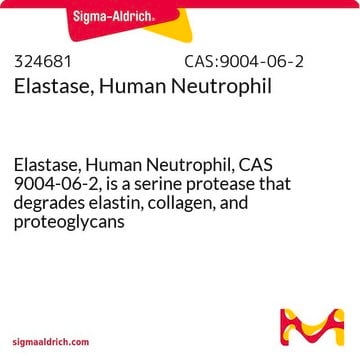219373
Cathepsin G, Human Neutrophil
Cathepsin G, Human Neutrophil, CAS 107200-92-0, is a purified native cathepsin G. Acts as a potent agonist of human platelet activation leading to their aggregation.
Sinónimos:
Cathepsin G, Human Neutrophil
About This Item
Productos recomendados
biological source
human neutrophils
Quality Level
assay
≥95% (SDS-PAGE)
form
lyophilized solid (Salt-free)
specific activity
≥2 units/mg protein
manufacturer/tradename
Calbiochem®
storage condition
OK to freeze
technique(s)
inhibition assay: suitable
suitability
suitable for molecular biology
application(s)
life science and biopharma
shipped in
ambient
Storage temp.
−20°C
Gene Information
human ... CTSG(1511)
General description
Cathepsin G is stored in its active form in azurophil granules of neutrophils or monocytes. Its mature form contains one potential glycan-binding site and three disulfide bonds.
Application
Biochem/physiol Actions
Warning
Unit Definition
Preparation Note
Reconstitute in 150 mM NaCl, 50 mM sodium acetate buffer, pH 5.5.
Reconstitution
Other Notes
Shamamian, P., et al. 2001. J. Cell Physiol.189, 197.
Groutas, W.C., et al. 1993. Biochem. Biophys. Res. Commun.197, 730.
Stone, P.J., et al. 1993. Biochem. Biophys. Res. Commun.197, 130.
Groutas, W.C., et al. 1992. Arch. Biochem. Biophys.294, 144.
Maison, C.M., et al. 1991. J. Immunol.147, 921.
Travis, J. 1988. Am. J. Med.84, 37.
Legal Information
Storage Class
11 - Combustible Solids
wgk_germany
WGK 3
flash_point_f
Not applicable
flash_point_c
Not applicable
Certificados de análisis (COA)
Busque Certificados de análisis (COA) introduciendo el número de lote del producto. Los números de lote se encuentran en la etiqueta del producto después de las palabras «Lot» o «Batch»
¿Ya tiene este producto?
Encuentre la documentación para los productos que ha comprado recientemente en la Biblioteca de documentos.
Nuestro equipo de científicos tiene experiencia en todas las áreas de investigación: Ciencias de la vida, Ciencia de los materiales, Síntesis química, Cromatografía, Analítica y muchas otras.
Póngase en contacto con el Servicio técnico






